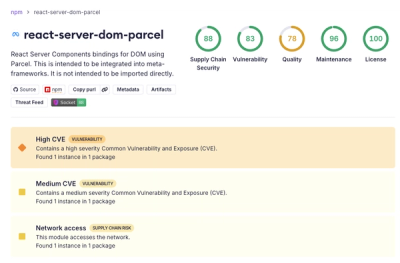
Security News
Deno 2.6 + Socket: Supply Chain Defense In Your CLI
Deno 2.6 introduces deno audit with a new --socket flag that plugs directly into Socket to bring supply chain security checks into the Deno CLI.
fdict
Advanced tools
|PyPI-Status| |PyPI-Versions|
|Build-Status| |Branch-Coverage-Status| |Codacy-Grade|
|LICENCE|
Easy out-of-core computing with recursive data structures in Python with a drop-in dict replacement. Just use sfdict() instead of dict(), you are good to go!
fdict and sfdict can be initialized with a standard dict:
.. code:: python
from fdict import fdict, sfdict
d = fdict({'a': {'b': 1, 'c': [2, 3]}, 'd': 4})
Out: {'a/c': [2, 3], 'd': 4, 'a/b': 1}
Nested dicts will be converted on-the-fly:
.. code:: python
d['e'] = {'f': {'g': {'h': 5}}}
Out: {'e/f/g/h': 5, 'a/c': [2, 3], 'd': 4, 'a/b': 1}
And it can be converted back to a dict at any time:
.. code:: python
d.to_dict_nested()
Out: {'a': {'c': [2, 3], 'b': 1}, 'e': {'f': {'g': {'h': 5}}}, 'd': 4}
To store all items on disk (out-of-core computing), use sfdict, a subclass of fdict using shelve internally:
.. code:: python
# Initialize an empty database in file myshelf.db
d = sfdict(filename='myshelf.db')
d['a'] = {'b': 1, 'c': [2, 3]}
d.sync() # synchronize all changes back to disk
d.close() # should always close a db
# Reopen the same database
d2 = sfdict(filename='myshelf.db')
print(d2)
d2.close()
Out: {'a/b': 1, 'a/c': [2, 3]}
The intention of this module is to provide a very easy and pythonic data structure to do out-of-core computing of very nested/recursive big data, while still having reasonably acceptable performances. Currently, no other library can do out-of-core computing of very recursive data, because they all serialize at 1st level nodes. Hence, the goal is to provide a very easy way to prototype out-of-core applications, which you can later replace with a faster datatype.
Hence, this module provides fdict() and sfdict(), which both provide a similar interface to dict() with flattened keys for the first and out-of-core storage for the second (using native shelve library). There is no third-party dependancy.
The fdict() class provides the basic system allowing to have an internal flattened representation of a nested dict, then you can subclass it to support your favorite out-of-core library as long as it implements dict-like methods: an exemple is provided with sfdict() using shelve, but you can subclass to use chest, shove, sqlite, zodb, etc.
Note: if you use sfdict(), do not forget to .sync() and .close() to commit the changes back to the file.
Alternatives, notably based on numpy and so probably faster but with fixed dimensions, can be found in the wendelin.core project <https://github.com/Nexedi/wendelin.core>, zarr <https://github.com/alimanfoo/zarr>, zict <http://zict.readthedocs.io/en/latest/>__ and there is also dask <https://dask.pydata.org/en/latest/>__ for pandas dataframes.
Although maximum compatibility was the primary goal, a different implementation of course brings differences that are unavoidable.
The primary difference is that calling items(), keys(), values() and view* methods will return all children leaves nested at any level, whereas a dict returns only the direct children. Also, by default, these methods return only leaves (non-dict objects) and not nodes, although you can override this by suppling the nodes=True argument.
Another difference is conflicts: you can have an item being both a leaf and a node, because there is no way to check that there is no node without walking all items (ie, using viewitems(), and this method is the limitation of fdict data structure).
This also means that when assigning an item that was already assigned, nodes will NOT get replaced, but singleton will be correctly replaced. To be more explicit:
This works:
.. code:: python
d = fdict({'a': 1, 'b': {'c': 2}})
d['a'] = -1
print(d)
d['a'] = {'d': 3, 'e': 4}
print(d)
{'a': -1, 'b/c': 2}
{'a/d': 3, 'a/e': 4, 'b/c': 2}
But this does NOT work as expected:
.. code:: python
d = fdict({'a': 1, 'b': {'c': 2}})
d['b'] = -1
print(d)
{'a': 1, 'b': -1, 'b/c': 2}
A minor difference is the handling of keys: assigning an empty dict to a key will not create the key (e.g. d['a'] = {} will not create the key a, it will stay inexistent until it gets assigned a non empty dict value), and assigning sub-keys that do not exist is ok without any prior parent dict creation (e.g. d = fdict(); d['a']['b']['c']['d']['e'] = 1 is OK).
Similarly, walking keys(), values() and items() will walk through all nested leaves at any nested level. For exploration convenience, if you want a behavior similar to dict to explore only the direct children displaying only the direct children, you can use viewkeys_restrict(), viewitems_restrict(), viewvalues_restrict(), firstkey(), firstitem(), firstvalue(). Note however that the walking will not be faster than walking all items (because internally that is what is being done), so you cannot optimize speed with these methods, it is only for convenience.
Another minor difference is how pop() and popitem() are handled: they will return the next leaf at any nested level, and never nodes. Thus, you cannot get the next item at a specific level, but only the next item at any nested level.
fdict was made with maximum compatibility with existing code using dict and with reasonable performances. That's in theory, in practice fdict are slower than dict for most purposes, except setitem and getitem if you use direct access form (eg, x['a/b/c'] instead of x['a']['b']['c']).
As such, you can expect O(1) performance just like dict for any operation on leaves (non-dict objects): getitem, setitem, delitem, eq contains. In practice, fdict is about 10x slower than dict because of class overhead and key string manipulation, for both indirect access (ie, x['a']['b']['c']) and 3x slower for direct access on leaves (ie, x['a/b/c']). Thus direct access form might be preferable if you want a faster set and get. This performance cost is acceptable for a quick prototype of a bigdata database, since building and retrieving items are the most common operations.
The major drawback comes when you work on nodes (nested dict objects): since all keys are flattened and on the same level, the only way to get only the children of a nested dict (aka a branch) is to walk through all keys and filter out the ones not matching the current branch. This means that any operation on nodes will be in O(n) where n is the total number of items in the whole fdict. Affected operations are: items, keys, values, view*, iter*, delitem on nodes, eq on nodes, contains on nodes.
Interestingly, getitem on nodes is not affected, because we use a lazy approach: getting a nested dict will not build anything, it will just spawn a new fdict with a different filtering rootpath. Nothing gets evaluated, until you either attain a leaf (in this case we return the non-dict object value) or you use an operation on node such as items(). Keep in mind that any nested fdict will share the same internal flattened dict, so any nested fdict will also have access to all items at any level!
This was done by design: fdict is made to be as fast as dict to build and to retrieve leaves, in exchange for slower exploration. In other words, you can expect blazingly fast creation of fdict as well as getting any leaf object at any nested level, but you should be careful when exploring. However, even if your dict is bigger than RAM, you can use the view* methods (viewitems, viewkeys, viewvalues) to walk all the items as a generator.
To circumvent this pitfall, two things were implemented:
* ``extract()`` method can be used on a nested fdict to filter all keys once and build a new fdict containing only the pertinent nested items. Usage is ``extracted_fdict = fdict({'a': {'b': 1, 'c': [2, 3]}})['a'].extract()``.
* ``fastview=True`` argument can be used when creating a fdict to enable the FastView mode. This mode will imply a small memory/space overhead to store nodes and also will increase complexity of setitem on nodes to O(m*l) where m is the number of parents of the current leaf added, and l the number of leaves added (usually one but if you set a dict it will be converted to multiple leaves). On the other hand, it will make items, keys, values, view* and other nodes operations methods as fast as with a ``dict`` by using lookup tables to access direct children directly, which was O(n) where n was the whole list of items at any level in the fdict. It is possible to convert a non-fastview fdict to a fastview fdict, just by supplying it as the initialization dict.
* ``nodel=True`` argument activates a special mode where delitem is nullified, but key lookup (contains test) time is O(1) for nodes. With standard ``fdict``, contains test is O(1) only for leaves and O(n) for nodes because it calls ``viewkeys()``. With this mode, empty nodes metadata are created and so lookup for nodes existence is very fast, but at the expense that deletion is not possible because it would make the database incoherent (i.e. nodes without leaf). However, setitem to replace a leaf will still work. This mode is particularly useful for fast database building, and then you can initialize a standard fdict with your finalized nodel fdict, which will then allow you to delitem.
Thus, if you want to do data exploration on a fdict, you can use either of these two approaches to speed up your exploration to a reasonable time, with performances close to a dict. In practice, extract is better if you have lots of items per nesting level, whereas fastview might be better if you have a very nested structure with few items per level but lots of levels.
There is probably room for speed optimization, if you have any idea please feel free to open an issue on Github.
Note that this module is compatible with PyPy <https://pypy.org/>__, so you might get a speed-up with this interpreter.
In any case, this module is primarily meant to do quick prototypes of bigdata databases, that you can then switch to another faster database after reworking the structure a bit.
A good example is the retrieval of online data: in this case, you care less about the data structure performance since it is negligible compared to network bandwidth and I/O. Then, when you have the data, you can rework it to convert to another type of database with a flat schema (by extracting only the fields you are interested in).
Also you can convert a fdict or sfdict to a flat dict using the to_dict() method, or to a nested (natural) dict using to_dict_nested(), you will then get a standard dict stored in RAM that you can access at full speed, or use as an input to initialize another type of out-of-core database.
fdict class
.. code:: python
class fdict(dict):
'''
Flattened nested dict, all items are settable and gettable through ['item1']['item2'] standard form or ['item1/item2'] internal form.
This allows to replace the internal dict with any on-disk storage system like a shelve's shelf (great for huge nested dicts that cannot fit into memory).
Main limitation: an entry can be both a singleton and a nested fdict: when an item is a singleton, you can setitem to replace to a nested dict, but if it is a nested dict and you setitem it to a singleton, both will coexist. Except for fastview mode, there is no way to know if a nested dict exists unless you walk through all items, which would be too consuming for a simple setitem. In this case, a getitem will always return the singleton, but nested leaves can always be accessed via items() or by direct access (eg, x['a/b/c']).
Fastview mode: remove conflicts issue and allow for fast O(m) contains(), delete() and view*() (such as vieitems()) where m in the number of subitems, instead of O(n) where n was the total number of elements in the fdict(). Downside is setitem() being O(m) too because of nodes metadata building, and memory/storage overhead, since we store all nodes and leaves lists in order to allow for fast lookup.
'''
def __init__(self, d=None, rootpath='', delimiter='/', fastview=False, nodel=False, **kwargs):
Parameters:
* d : dict, optional
Initialize with a pre-existing dict.
Also used internally to pass a reference to parent fdict.
* rootpath : str, optional
Internal variable, define the nested level.
* delimiter : str, optional
Internal delimiter for nested levels. Can also be used for
getitem direct access (e.g. ``x['a/b/c']``).
[default : '/']
* fastview : bool, optional
Activates fastview mode, which makes setitem slower
in O(m*l) instead of O(1), but makes view* methods
(viewitem, viewkeys, viewvalues) as fast as dict's.
[default : False]
* nodel : bool, optional
Activates nodel mode, which makes contains test
in O(1) for nodes (leaf test is always O(1) in any mode).
Only drawback: delitem is not suppressed.
Useful for quick building of databases, then you can
reopen the database with a normal fdict if you want
the ability to delitem.
[default : False]
Returns:
* out : dict-like object.
sfdict class
.. code:: python
class sfdict(fdict):
'''
A nested dict with flattened internal representation, combined with shelve to allow for efficient storage and memory allocation of huge nested dictionnaries.
If you change leaf items (eg, list.append), do not forget to sync() to commit changes to disk and empty memory cache because else this class has no way to know if leaf items were changed!
'''
def __init__(self, *args, **kwargs):
Parameters:
x['a/b/c']).
[default : '/']Returns:
This library is licensed under the MIT License. It was initially made for the Coma Science Group - GIGA Consciousness - CHU de Liege, Belgium.
Included are the flatkeys function by bfontaine <https://github.com/bfontaine/flatkeys>__ and _count_iter_items by zuo <https://stackoverflow.com/a/15112059/1121352>__.
.. |Build-Status| image:: https://travis-ci.org/lrq3000/fdict.svg?branch=master :target: https://travis-ci.org/lrq3000/fdict .. |LICENCE| image:: https://img.shields.io/pypi/l/fdict.svg :target: https://raw.githubusercontent.com/lrq3000/fdict/master/LICENCE .. |PyPI-Status| image:: https://img.shields.io/pypi/v/fdict.svg :target: https://pypi.python.org/pypi/fdict .. |PyPI-Downloads| image:: https://img.shields.io/pypi/dm/fdict.svg :target: https://pypi.python.org/pypi/fdict .. |PyPI-Versions| image:: https://img.shields.io/pypi/pyversions/fdict.svg :target: https://pypi.python.org/pypi/fdict .. |Branch-Coverage-Status| image:: https://codecov.io/github/lrq3000/fdict/coverage.svg?branch=master :target: https://codecov.io/github/lrq3000/fdict?branch=master .. |Codacy-Grade| image:: https://api.codacy.com/project/badge/Grade/3f965571598f44549c7818f29cdcf177 :target: https://www.codacy.com/app/lrq3000/fdict?utm_source=github.com&utm_medium=referral&utm_content=lrq3000/fdict&utm_campaign=Badge_Grade
FAQs
Easy out-of-core computing of recursive dict
We found that fdict demonstrated a healthy version release cadence and project activity because the last version was released less than a year ago. It has 1 open source maintainer collaborating on the project.
Did you know?

Socket for GitHub automatically highlights issues in each pull request and monitors the health of all your open source dependencies. Discover the contents of your packages and block harmful activity before you install or update your dependencies.

Security News
Deno 2.6 introduces deno audit with a new --socket flag that plugs directly into Socket to bring supply chain security checks into the Deno CLI.

Security News
New DoS and source code exposure bugs in React Server Components and Next.js: what’s affected and how to update safely.

Security News
Socket CEO Feross Aboukhadijeh joins Software Engineering Daily to discuss modern software supply chain attacks and rising AI-driven security risks.